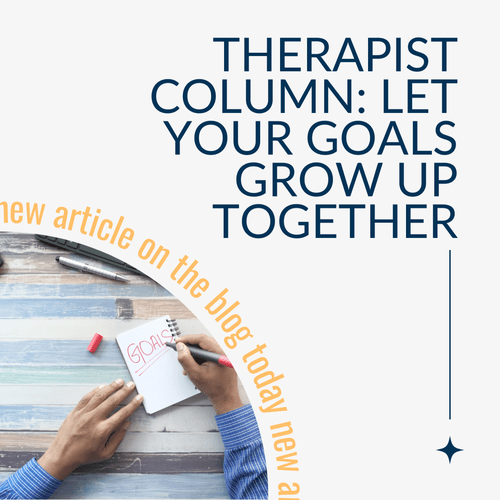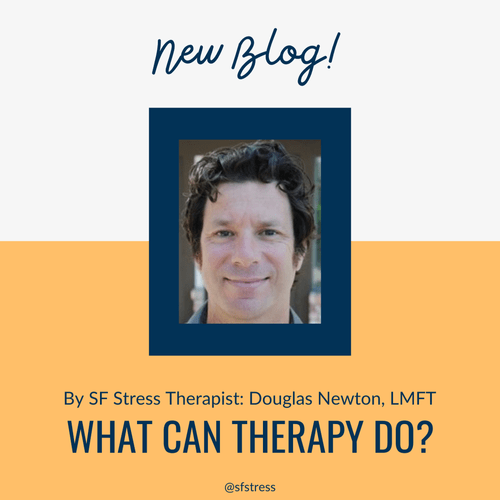What Can Therapy Do? By Douglas Newton, LMFT
The Idea: Diminish your anxiety to let your goals grow up together
Many of my clients experience anxiety because the goals and objectives they have in their lives have been put off. “I’ll get to dating as soon as I lose some weight,” or “I have to move out of this apartment before I think about getting a new job.” This kind of thinking places artificial barriers in front of the flow of one’s life. It is common among many of us and I have entitled the placement of hurdles as artificial sequencing. Artificial sequencing establishes priority that favors one objective arbitrarily over another. Is it reasonable to begin dating while also working on getting into shape? How does moving out of an apartment become a reason not to look for a more satisfying job? Understanding why we sometimes think this way helps to identify the pattern and then look for ways to use our awareness to let our goals grow up together.
What is going on here? The brain acts to protect you from challenges that increase anxiety
Artificial sequencing is a way of placing obstacles in your path. The adaptive reason to do this comes from our brain’s need to insulate us from anxiety. If there is something that we want that involves risk, our brain can often exaggerate that risk and stop us in our tracks. This intuitive reaction warps the way we understand our experiences. We miss out on a more grounded understanding of calculated risk. Would your supervisor actually fire you if you asked for a promotion? She likely wouldn’t. But your brain exaggerates the risk, possibly because of childhood experiences that made you feel unsafe in some way. Maybe asking mom or dad for a privilege as a child was met with put-downs or harsh words. This could lead you to fear confrontation with authority figures as an adult, even if the stakes are low. Such trepidation may be totally off your radar. And yet this unconscious protective instinct influences what you see as acceptable risk as an adult. You might think, “I will see if I can ace my next project. If it is flawless, maybe my supervisor will give me a promotion.” The project and the need for perfection may be exaggerated because imperfection opened you to criticism or derision as a kid. The thinking may be delusional as an adult, but the roots are strong that inform your way of perceiving potential conflict. Asking directly may feel like an untenable risk due to deeply entrenched fear. That pit in your stomach tells you to wait until the right time, and that it is safer to defer your needs, maybe even indefinitely.
What to do? Navigate your patterns with Forgiveness and Mindfulness
Forgiveness can sound like letting someone off the hook. But forgiveness has more to do with how we process emotions from difficult experiences rather than accountability. Forgiveness offers a way to let go of things that are weighing us down. We may not even know these things exist until we use our awareness to scan our mind for what we might be carrying.
Search your heart for resentment or unresolved emotions from your past. Maybe you are still angry about something that happened when you were young or hurt from unkind remarks people made in high school or college. Your awareness can locate these moments and then bring self-compassion into service aimed at your painful memory. Imagine how hard it is for a kid to stand up to an adult. The person you may need to forgive could be that confused 6 year old you used to be. Write a letter to your former self and think about how you did the best you could with what you knew at the time. This shift in thinking can change the way you see your upsetting experience. Invest yourself fully into how good it feels to forgive yourself or someone else. Then you can harvest what you learned, such as your ability to overcome challenges or how tough experiences have helped you become independent minded. Take a moment to take in the usefulness of those qualities and how you value them in yourself. Then use your awareness to let go. Imagine taking resentment and folding it into a paper boat that you place into a river. You wave goodbye to it, with love and gratitude for your new understanding of yourself, as you watch that paper boat head to the sea.
This is not to imagine there are truly traumatic experiences that require further processing and more advanced techniques. But for many of our resentments and wounds, reframing can give you a different perspective and allow you a newfound presence in your life.
Your therapist can help you explore this kind of tool and many others to help you reframe your past and put painful memories into perspective–what I sometimes call “a smaller box.” Using your ability to be mindful (observation without judgment) can help you eventually see these experiences as patterns. Thinking in patterns can reduce feelings of shame, blame and judgment. This is hard work! But eventually, with the stewardship of therapy, you can free yourself from the eclipsing power of difficult memories and use this footing to advocate for yourself, embrace the opportunities as they come, contextualize challenges and absorb them with grace, and find more compassion for yourself and others in your life.
Once you encounter less situationally-driven anxiety, you can open your heart to those goals and objectives that will nourish your life without getting in your own way. There is so much to explore when we feel a new sense of purpose and self-efficacy. Finding your footing through mindfulness and forgiveness can expand your sense of safety to allow more breathing room for all your agenda. It’s hard enough to work into a place where we get much of what we want. But the path is made easier when we clear our own hurdles out of the way.
If you don’t yet have a therapist, consider employing the experts at SF Stress & Anxiety Center. Clear the fog. Find and expand your center. Get the help that makes a concrete difference in your life and how you relate to yourself, others and the world. Click the button below to schedule a time to speak to a Care-Coordinator.



